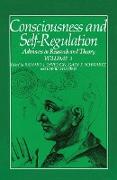- Start
- Consciousness and Self-Regulation
Consciousness and Self-Regulation
Angebote / Angebote:
1 A Reason for Doubting the Existence of Consciousness.- I. Definitions.- II. The Cartesian Intuition.- III. The Computational-Representational Theory of Mind.- IV. The Problem of Consciousness.- V. Appendix.- A. Formal Logic.- B. Intensionality.- C. Logic and Computation.- D. Self-Reference and the Rest of G¿del.- References.- 2 Conscious Contents Provide the Nervous System with Coherent, Global Information.- I. Brief Overview.- II. Introduction.- A. The Need for a Central Information Exchange in a Distributed Processing System: Some Theoretical Definitions.- B. The System in Operation.- C. Advantages of the Global Data Base.- D. Disadvantages of the Global Data Base.- III. Capability Constraints: Arguments for Associating Consciousness with a Global Data Base.- A. Computational Inefficiency.- B. Some Advantages of Conscious Processes.- C. Apparent Unity, Seriality, and Limited Capacity.- IV. The Boundaries of Conscious Contents.- A. Contexts.- B. Undefined Inputs.- C. Global Information and Global Redundancy.- D. Preperceptual Processing.- V. Summary and Conclusions.- A. Extensions of the Theory.- B. Conclusion.- References.- 3 Event-Related Brain Potentials in the Study of Consciousness.- I. Introduction.- A. A Phenomenological Approach to Consciousness.- B. The Event-Related Brain Potential: A Brief Survey.- II. ERPs, Threshold, and Subliminal Perception.- III. The Contents of Consciousness and ERPs.- IV. The ERP and Information Processing.- V. The ERPs and Consciousness.- References.- 4 Anxiety and Fear: Central Processing and Peripheral Physiology.- I. Three Data Systems in Emotion.- A. Affective Behavior: Concordance and Discordance.- II. Language and Affect: The Emotional Image.- A. Physiology of the Image.- B. Processing the Image: Definition and Theory.- C. Emotional Imagery and Text Processing.- III. Research: Script, Image, and Behavior.- A. Experiment I.- B. Experiment II.- C. Experiment III.- D. Experiment IV.- IV. Clinical Implications of Imagery Theory.- A. Imagery and Behavior Change.- B. Reality and Image: The Participatory Set.- V. Summary and Conclusions.- References.- 5 Meditation: In Search of a Unique Effect.- I. Psychophysiological State Effects.- A. EEG Sleep Stages.- B. Oxygen Consumption: Does TM Produce a Hypometabolic State?.- C. Relaxation Response or Multiprocess Model.- D. Multiprocess Model: Cognitive and Somatic Relaxation.- E. Relaxation under Stress.- F. EEG Alpha and Theta Activity.- II. Hemispheric Dominance.- A. Performance Measures.- B. EEG Alpha Asymmetry during Performance.- C. Does TM Induce a Shift in Hemispheric Dominance?.- III. Personality Traits.- IV. Clinical Outcome Effects.- V. Conclusion.- A. State Effects.- B. Trait Effects.- References.- Author Index.
Folgt in ca. 5 Arbeitstagen




